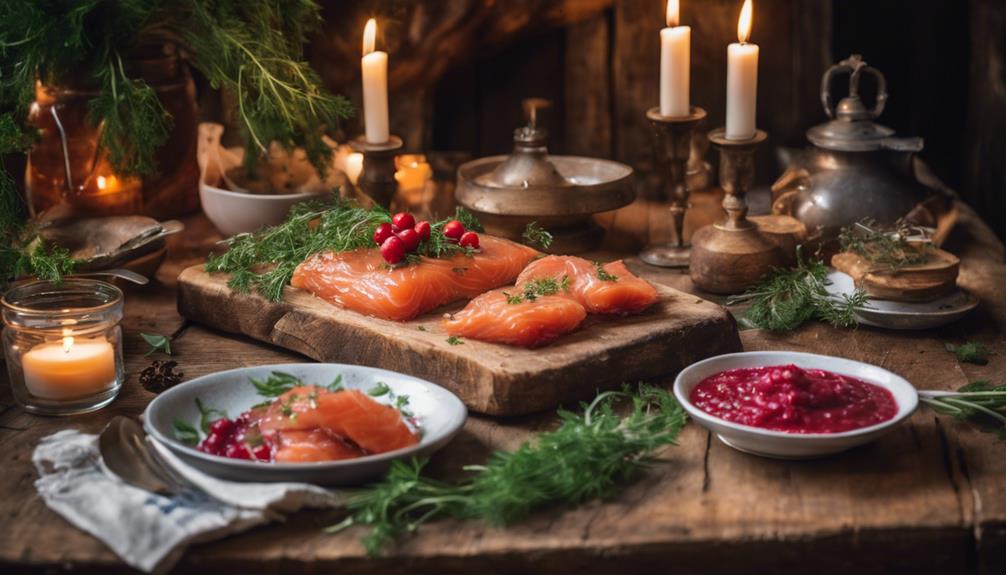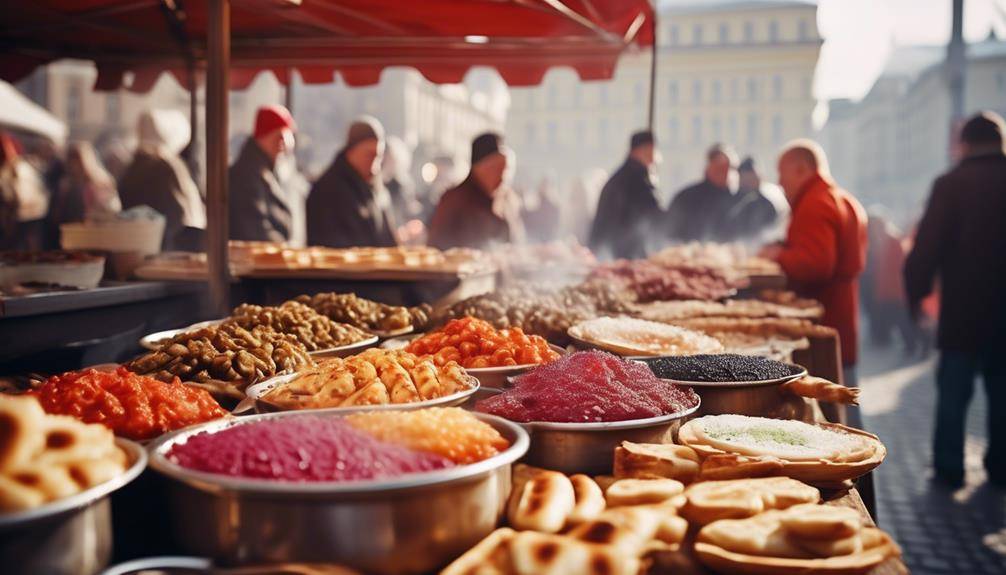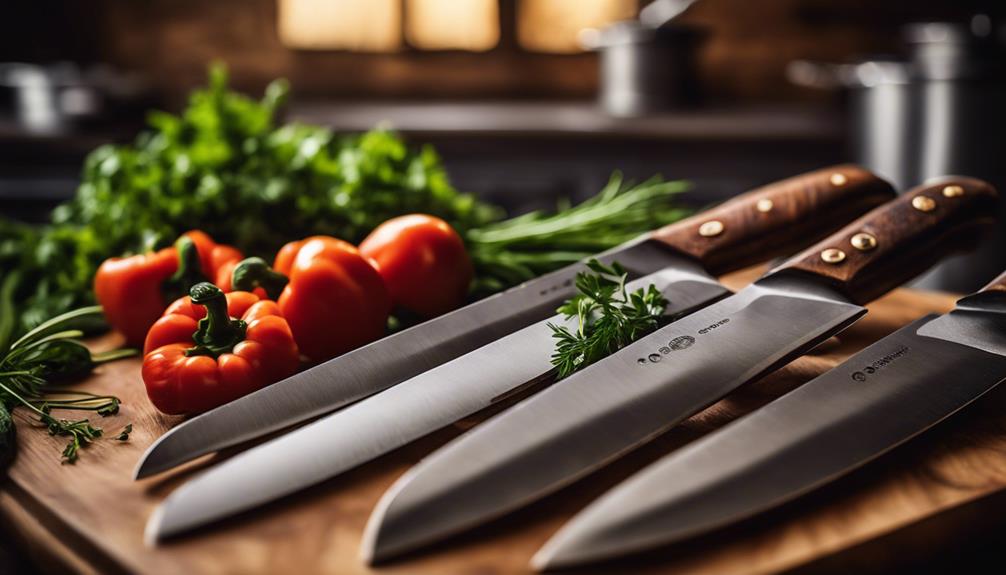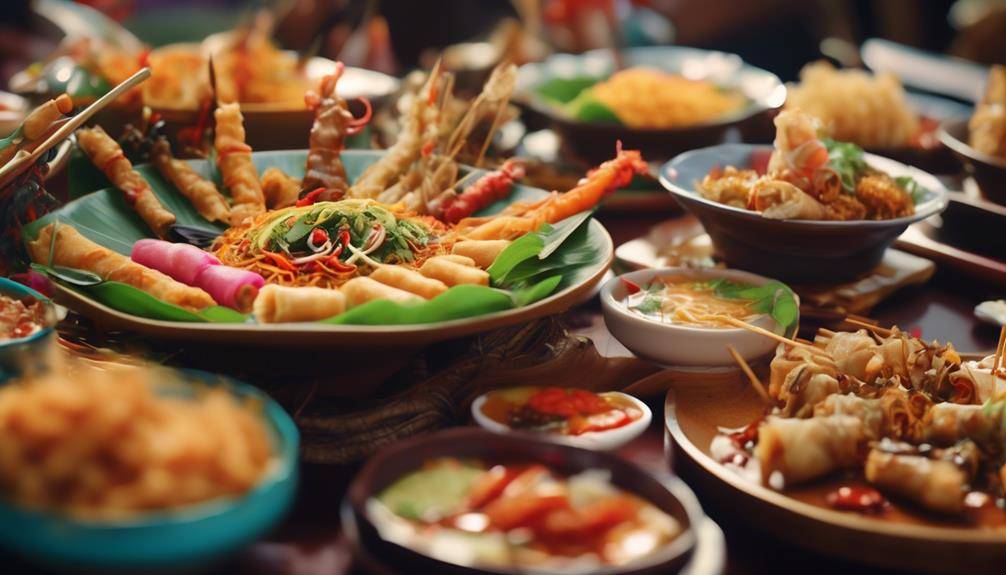Great Reasons Why Beginners Should Try Swedish Cuisine

Why Beginners Should Try Swedish Cuisine; If you’re a beginner, trying Swedish cuisine can be a rewarding experience. You’ll discover unique flavors like the sweet-tart taste of lingonberries paired with savory meatballs. Swedish dishes emphasize fresh, seasonal ingredients and simple techniques, making them accessible for any cook. Plus, you’ll enjoy health benefits from nutrient-rich foods like whole grains and fermented items. With iconic options like Gravlax and Kanelbullar, there’s plenty to explore. Embracing these culinary practices not only teaches you new skills but also deepens your appreciation for Sweden’s rich food culture. Keep going, and you’ll find even more delicious insights waiting for you!
Unique Flavors and Ingredients
Have you ever wondered what makes Swedish cuisine stand out? One of the most intriguing aspects is its unique flavors, which stem from a deep appreciation for seasonal ingredients. In Sweden, the changing seasons dictate the types of produce available, leading to a culinary landscape that celebrates freshness and quality. You’ll find root vegetables and hearty grains in the colder months, while spring and summer bring an abundance of berries, greens, and fish.
Regional variations further enhance Swedish cuisine’s uniqueness. Each area boasts its own specialties, influenced by local traditions and available resources. For instance, on the west coast, you’ll savor fresh seafood like herring and shrimp, while the northern regions offer reindeer and cloudberries, reflecting the Arctic environment. Exploring these regional differences can turn a meal into a delightful journey across the country.
Don’t forget about the flavors that define traditional dishes! You’ll encounter bold combinations, like the savory sweetness of lingonberries paired with meatballs or the rich taste of gravlax. These unique ingredients not only showcase Sweden’s culinary heritage but also provide a fresh twist on familiar flavors. As you immerse yourself in Swedish cuisine, you’ll discover how these seasonal ingredients and regional variations come together to create a memorable dining experience. So, why not take the plunge and explore the unique flavors of Sweden? You may find that it’s a delicious adventure waiting for you!
Simple Cooking Techniques
Exploring Swedish cuisine isn’t just about the unique flavors and ingredients; it’s also about mastering simple cooking techniques that bring those flavors to life. You don’t need to be a professional chef to create delightful dishes; just focus on a few basic skills that can elevate your cooking experience.
Start with ingredient preparation. Knowing how to clean, chop, and store your ingredients is essential. For instance, when working with root vegetables like potatoes and carrots, a good peeler and a sharp knife can make all the difference. Practice dicing and julienning to enhance the texture of your dishes. Simple techniques like sautéing or roasting can bring out the natural sweetness of these vegetables, a hallmark of Swedish cooking.
Next, get comfortable with boiling and simmering, especially for creating broths or soups, which are staples in Swedish cuisine. A simple vegetable broth can serve as a foundation for many recipes, so mastering this technique is a great investment of your time.
Don’t forget about baking, either! Traditional Swedish pastries often require a gentle touch and precise measurements. By practicing these basic skills, you’ll develop the confidence to experiment with flavors and techniques.
Incorporating these simple cooking methods into your routine will not only make your meals more enjoyable but also connect you to the rich culinary traditions of Sweden. So, roll up your sleeves and get started; the world of Swedish cuisine awaits!
Health Benefits of Swedish Food
Swedish food offers a plethora of health benefits that can enhance your overall well-being. One of the key aspects of Swedish cuisine is its focus on nutrient density. Many traditional dishes are packed with vitamins, minerals, and healthy fats, making them an excellent choice for anyone looking to improve their diet. For example, dishes featuring fish, such as herring and salmon, provide omega-3 fatty acids, which are essential for heart health and brain function.
Another significant benefit of Swedish food is its emphasis on seasonal produce. By incorporating fruits and vegetables that are in season, you not only enjoy fresher flavors but also consume produce at its peak nutritional value. Seasonal eating encourages you to explore a variety of ingredients, which can help you maintain a balanced diet rich in essential nutrients. Root vegetables, berries, and greens are often staples in Swedish meals, each offering unique health benefits.
Moreover, traditional Swedish meals often include whole grains, such as rye and barley, which can support digestive health and provide sustained energy throughout the day. The use of fermented foods, like pickled vegetables and sourdough bread, adds probiotics to your diet, promoting gut health.
Incorporating Swedish cuisine into your meals can be a delicious way to prioritize your health. By enjoying nutrient-dense dishes made with seasonal produce, you’ll not only nourish your body but also discover the joy and flavors of Swedish cooking.
Iconic Dishes to Explore
When diving into Swedish cuisine, you’ll encounter a variety of iconic dishes that showcase the country’s rich culinary heritage. One of the first things you should try is meatballs, or “köttbullar.” These tender, flavorful bites are often served with creamy gravy, lingonberry sauce, and creamy mashed potatoes. They’re a staple of traditional meals and a favorite among locals.
Another dish that demands your attention is gravlax, a cured salmon that’s both delicate and delicious. It’s typically served with a mustard-dill sauce and crisp bread, making it perfect for light lunches or festive feasts. When you’re in the mood for something heartier, try “jägargryta,” a comforting hunter’s stew made with tender meat and seasonal root vegetables.
Don’t forget about “knäckebröd,” the iconic crispbread that you can pair with almost anything, from cheese to cured meats. It’s a fantastic side for any traditional meal. For dessert, indulge in “kanelbullar,” sweet cinnamon buns that are perfect with coffee. These are often enjoyed during Fika, a cherished Swedish coffee break.
If you’re looking for something truly festive, explore “julbord,” a traditional Swedish Christmas buffet featuring everything from herring to roasted ham. It’s a great way to experience a variety of flavors in one sitting. With each dish you try, you’ll discover the warmth and creativity that defines Swedish cuisine. So, get ready to explore these iconic dishes and embrace a culinary adventure!
Cultural Significance of Cuisine
When you explore Swedish cuisine, you’ll uncover its rich historical roots that shape each dish. Traditional ingredients and flavors tell stories of the land and its people, while culinary customs and practices reflect the culture’s values. Understanding these elements will enhance your appreciation of Swedish food beyond just taste.
Historical Roots of Cuisine
Exploring the historical roots of Swedish cuisine reveals a rich tapestry woven from centuries of cultural influences and regional practices. You’ll notice how this culinary journey reflects Sweden’s Nordic heritage, shaped by geography, climate, and the availability of local ingredients. The harsh winters led to preservation techniques like smoking and pickling, which are still prominent today.
As you dive deeper, you’ll see how trade routes and neighboring countries contributed to Sweden’s culinary evolution. Spices from distant lands began to make their way into Swedish kitchens, enriching traditional dishes and creating a unique blend of flavors. The influence of neighboring cultures, particularly from Denmark and Finland, also played a significant role in shaping what you now recognize as Swedish cuisine.
Additionally, historical events, such as the agricultural reforms of the 19th century, transformed food production and consumption patterns. This evolution not only reflects Sweden’s adaptability but also its commitment to sustainability, which you’ll find resonates in modern Swedish cooking. Embracing these historical roots helps you appreciate the depth and character of Swedish cuisine, making your culinary exploration all the more rewarding.
Traditional Ingredients and Flavors
At the heart of Swedish cuisine lies a selection of traditional ingredients that not only define its flavors but also embody cultural significance. You’ll find that seasonal produce plays an essential role in creating authentic Swedish dishes. From fresh berries in summer to root vegetables in winter, these ingredients reflect the changing seasons and the connection Swedes have with nature.
Traditional preservation methods like pickling, curing, and drying are also vital. These techniques were developed out of necessity, allowing people to enjoy food throughout the long, harsh winters. For example, pickled herring and cured meats are staples that showcase the importance of preserving seasonal catch and livestock.
When you explore dishes like gravlax or surströmming, you’ll appreciate how these traditional ingredients and flavors tell a story of resourcefulness and respect for the land. Each taste offers a glimpse into Sweden’s agricultural heritage and culinary history. So, as you immerse yourself in Swedish cuisine, remember that every bite is infused with a sense of place and time, making it a delightful adventure for your palate.
Culinary Customs and Practices
Swedish cuisine isn’t just about the food; it’s woven into the fabric of daily life and cultural celebrations. When you engage in Swedish cooking, you’ll notice the importance of meal traditions that reflect the nation’s values and social customs. For instance, the concept of “fika,” a coffee break accompanied by pastries, plays a significant role in Swedish society, promoting relaxation and connection among friends and colleagues.
Dining etiquette in Sweden emphasizes simplicity and respect. You should always wait for the host to start the meal, and it’s considered polite to keep your hands on the table (but not your elbows). Don’t be surprised if you encounter “smörgåsbord,” a buffet-style meal that showcases a variety of dishes, allowing everyone to sample the flavors of the season.
Another important custom is celebrating Midsummer, where traditional foods like herring and new potatoes take center stage. These culinary practices not only enhance your dining experience but also provide insight into the rich cultural heritage of Sweden. So, as you explore Swedish cuisine, immerse yourself in these customs to truly appreciate what’s on your plate.
Easy Recipes for Beginners
If you’re new to Swedish cooking, you’ll love these easy recipes that anyone can tackle. Start with simple Swedish meatballs, whip up a quick lingonberry sauce, or bake some delightful cinnamon buns. These dishes will have you enjoying the flavors of Sweden in no time!
Simple Swedish Meatballs
There’s something comforting about a plate of homemade meatballs, and making simple Swedish meatballs is a perfect introduction to this beloved dish. These tender, flavorful bites are easy to prepare, making them ideal for beginners. Start by mixing ground beef and pork with breadcrumbs, minced onions, and spices like allspice and nutmeg. Form the mixture into small balls and fry them until golden brown.
You can explore meatball variations by adding different herbs or using turkey for a lighter option. If you want a touch of richness, consider incorporating grated cheese into the mix.
When it comes to serving suggestions, these meatballs are traditionally served with creamy gravy and mashed potatoes, creating a hearty meal. You could also pair them with lingonberry sauce for a sweet contrast. For a lighter touch, serve them over a bed of sautéed greens or in a sub with your favorite toppings.
With their versatility and comforting flavors, simple Swedish meatballs are sure to impress anyone at your dinner table. Enjoy your culinary adventure as you plunge into the delightful world of Swedish cuisine!
Quick Lingonberry Sauce
While you might think making sauce is complicated, whipping up a quick lingonberry sauce is surprisingly easy and requires just a few ingredients. Lingonberries, with a rich history in Swedish cuisine, have been used for centuries to enhance flavors and provide a tart contrast to savory dishes.
To make this sauce, you’ll need fresh or frozen lingonberries, sugar, and a splash of water. Simply combine these ingredients in a saucepan over medium heat. Stir occasionally until the berries burst and the mixture thickens, which should take about 10 minutes. You can adjust the sweetness based on your taste, and that’s the beauty of this recipe—there are countless sauce variations.
Some people like to add a hint of cinnamon or even a splash of lemon juice for an extra kick. Once it’s done, serve it alongside Swedish meatballs, pancakes, or even roasted meats. This quick lingonberry sauce not only brightens your plate but also gives you a taste of traditional Swedish flavors. Immerse yourself in this easy recipe, and you’ll see just how rewarding it is to create a piece of lingonberry history in your own kitchen!
Easy Cinnamon Buns
After enjoying the tart sweetness of homemade lingonberry sauce, it’s time to turn your attention to another beloved Swedish treat: easy cinnamon buns. These delightful pastries make for a perfect introduction to Swedish baking. With simple ingredients and straightforward steps, you’ll soon master the essential cinnamon techniques that bring these buns to life.
Start by mixing flour, sugar, yeast, and milk to create a soft dough. Let it rise until it doubles in size. Once your dough is ready, roll it out, spread a luscious layer of butter, sprinkle cinnamon, and add sugar. Feel free to experiment with bun variations, like adding cardamom for an extra flavor twist or incorporating nuts or raisins for texture.
Roll the dough tightly, slice it into rounds, and place them on a baking tray. Bake until golden brown, and enjoy the warm, aromatic scent filling your kitchen. Glaze with icing or serve them plain; either way, these easy cinnamon buns will impress your family and friends. Immerse yourself in this Swedish classic, and you’ll find that baking can be both fun and rewarding!
Frequently Asked Questions: Why Beginners Should Try Swedish Cuisine
What Are the Most Common Spices Used in Swedish Cooking?
In Swedish cooking, you’ll often use common spices like dill, cardamom, and allspice. You’ll also find unique Swedish herbs and spice combinations, enhancing dishes like herring, meatballs, and traditional pastries. Enjoy experimenting!
Are There Vegetarian Options in Traditional Swedish Cuisine?
Yes, there are vegetarian options in traditional Swedish cuisine. You can enjoy vegetarian adaptations of classic dishes like meatballs and gravlax, using ingredients like mushrooms, lentils, and root vegetables to create delicious, authentic flavors.
How Do Seasonal Ingredients Influence Swedish Dishes?
Seasonal ingredients play a huge role in Swedish dishes, enhancing the seasonal flavors you experience. By visiting local markets, you’ll discover fresh produce that inspires traditional recipes, making your meals more vibrant and connected to nature.
What Is the History Behind Swedish Meatballs?
Swedish meatballs, rooted in Swedish traditions, evolved through centuries, blending influences from various cultures. You’ll discover how culinary evolution shaped these iconic dishes, reflecting the country’s history and tastes, making them a beloved staple today.
Where Can I Find Authentic Swedish Ingredients Locally?
You can find authentic Swedish ingredients at local Swedish markets or specialty grocery stores. Online stores also offer a wide selection, making it easy for you to stock up on everything you need for your cooking adventures.
Conclusion
Trying Swedish cuisine as a beginner is a delicious adventure waiting for you. With its unique flavors, simple cooking techniques, and health benefits, you’ll find plenty to enjoy. Exploring iconic dishes not only satisfies your taste buds but also connects you to Sweden’s rich cultural heritage. Plus, easy recipes make it accessible and fun. So, grab some ingredients and start cooking; you’ll discover that Swedish food is not just nourishing but also a delightful experience!








